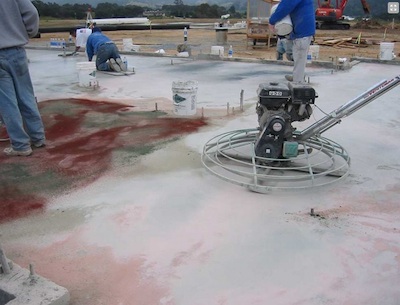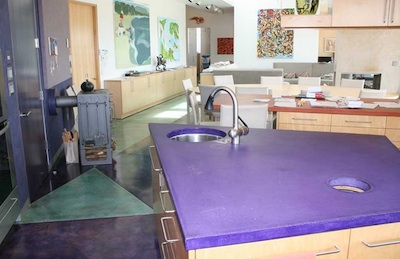In this volume of Decorative Concrete Master Q&A, Tom Ralston enlightens us on the subject of using color in concrete. There are two methods discussed, the first is integral color, the second is dust-on color hardener. Tom explains processes, do's and don'ts, cost, and shares personal experiences with using color in decorative concrete - giving expert insight from his 30+ year career.
Briefly, what is integral color and what is dust-on color?
 Tom Ralston: Integral color is simply pigment, pure pigment, put inside the drum of a concrete mixing truck. This is all done at the concrete plant. Pigment is added with water and the water is then mixed in the drum with the cement, sand, and aggregate.
Tom Ralston: Integral color is simply pigment, pure pigment, put inside the drum of a concrete mixing truck. This is all done at the concrete plant. Pigment is added with water and the water is then mixed in the drum with the cement, sand, and aggregate.
Dust on color is pigment mixed with sand and cement. It's stored in a bag or bucket and it is broadcast mechanically or by hand after the natural concrete has been poured.
What are the benefits and downsides of the dust-on and integral color methods?
Tom Ralston: Well, we here at TRC prefers dust on, but here are the benefits and downsides of each...
Integral Color
Integral color is much easier to use because it's less labor intensive. The finishers do not have to open a bag, manually broadcast the color onto the surface, and then work it in.
The integral color that comes from the concrete plants is already mixed in the load so it's much more convenient. However, the integral color from the plant can be much more inconsistent.
There's very little control. If it takes three to four trucks to finish a job and one truck comes to the job with too much water, the color in that load will be different than the other trucks. If they come back to the plant and don't wash their trucks the loads can be a completely different color. That's an inherent problem many times with integral colored concrete. When the person mixing batches at the plant introduces color, they must be very consistent. If they're not the colors will vary between batches.
Dust-On Color Hardener
 With dust-on color hardener, a finisher uses the same batch over and over. As long as the entire project has one batch from a manufacturer you should be good. If, however, you use batches of dust-on color from different years or manufacturers, you can have a similar problem in that the batches are not the same. One way to rectify that is to open all the color hardener buckets or bags and blend them together.
With dust-on color hardener, a finisher uses the same batch over and over. As long as the entire project has one batch from a manufacturer you should be good. If, however, you use batches of dust-on color from different years or manufacturers, you can have a similar problem in that the batches are not the same. One way to rectify that is to open all the color hardener buckets or bags and blend them together.
One of the benefits of using dust-on color is that you can use buckets from the original pour, store them, and if you ever have chips in the concrete or areas that need repair you can use the dust-on color hardener to repair the chips and get a perfect color match. If your concrete chips with integral color, even though the color is mixed throughout concrete you will have a difficult time matching the integral color, because you don't have the benefit of having that exact batch from the original pour.
One of the reasons a lot of concrete contractors don't use dust-on color hardener, is because it requires more effort, experience, and concrete craftsmanship to apply it. A lot of concrete masons aren't experienced with using dust-on color hardener.
The benefit for using dust on-color is that it becomes more of a dense surface, more scratch resistant - the colors hold better.
Integral color will variegate more easily, especially if you use some water on an integral color concrete. Using water on integral color usually spells disaster. It will bleed and come out in an unsightly mottled fashion.
What are your personal favorite applications of integral color?

Tom Ralston: You can use integral color on a countertop, a pool deck, on a swimming pool coping, on an interior floor... virtually any concrete pour can use integral color.
One of my favorite applications is when you have an exposed aggregate surface. For example say you use a red river rock as an aggregate, if you just put a small hint of red as your integral color when you do a wash off to expose the aggregate you don't see grey spots that will show up if you pour with no color added.
Predominantly in exposed aggregate surfaces there is going to be some negative spaces where the aggregate is not carpeted or tightly matrixed on your surface. Wherever there is a hole or space without colored aggregate, if you have an integral color in the load, those spaces become a lot less noticeable.
What is the cost difference of using integral color versus dust-on color?
Tom Ralston: Usually integral color starts with one pound per sack of cement. Each pound is around five dollars so it's around thirty dollars a yard. Two pounds of color-per-sack is sixty dollars a yard, three pounds of color per sack is ninety, four pounds of color per sack is one-hundred and twenty dollars. So you can see how expensive it can get. If you use green or a blue color they are more expensive for integral concrete - up to two-hundred dollars a yard.
The cost of dust-on color usually starts around sixty cents per square foot and it can go up to one dollar and fifty cents per square foot for using a bright white color. White colors get dusted on in four different applications! Whereas just using grey or brown you don't have to dust as much on, hence it costs less.
Can you tell a story about a remarkable use of integral color? A favorite project where you used it?
 Tom Ralston: A few years ago we used a taupe color, where we had strips of brass running through the work. The walls that we poured were acid-washed later to give it a sand-wash exposure. It was for the Watson family Victorian home in Santa Cruz. The Watson home was owned by the family that Watsonville is named after. It was a remarkable use of integral color.
Tom Ralston: A few years ago we used a taupe color, where we had strips of brass running through the work. The walls that we poured were acid-washed later to give it a sand-wash exposure. It was for the Watson family Victorian home in Santa Cruz. The Watson home was owned by the family that Watsonville is named after. It was a remarkable use of integral color.
There is one other funny story I can think of using integral color- it was a last ditch effort. The client wanted a black color and when we got to the job we hadn't ordered the black color. The client was very upset, and I was trying to hold my calm. I said, "I'll be right back, I'll take care of it. Don't worry".
So I went to the concrete company (this is before I was introduced to dust-on color hardener), and grabbed bags of the black powdered pigment and then I flew back to the job in my truck. When I got there I dusted all the pigment on (this is not recommended practice) - just threw straight pigment on the concrete and worked it in with wooden floats until it was black as black could be.
Then we seeded aggregate on top of that and when we washed it off the next day the black held really well! That job was done in 1992 and 22 years later the project still has that black color hardener. When I finished the client looked at me and said, "Uh, I don't think this is the way you're supposed to do things". It was beautiful and it worked out for the best, I completely lucked out.
Alright folks, that's it for this week's Decorative Concrete Master Q&A, join us next time for more stories and knowledge from decorative concrete master Tom Ralston. We post these Master Q&A's on the first and third Fridays of each month.
Submit your own questions here, and to find more information check out Tom's books on decorative concrete. Also, we'd love it if you'd come over and say hello on one of our social sites. Follow us or like us for more expert decorative concrete knowledge on Houzz, LinkedIn, Facebook or Instagram.
